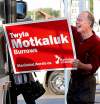Shift in vote by women could decide the election
Advertisement
Read this article for free:
or
Already have an account? Log in here »
To continue reading, please subscribe:
Monthly Digital Subscription
$1 per week for 24 weeks*
- Enjoy unlimited reading on winnipegfreepress.com
- Read the E-Edition, our digital replica newspaper
- Access News Break, our award-winning app
- Play interactive puzzles
*Billed as $4.00 plus GST every four weeks. After 24 weeks, price increases to the regular rate of $19.00 plus GST every four weeks. Offer available to new and qualified returning subscribers only. Cancel any time.
Monthly Digital Subscription
$4.75/week*
- Enjoy unlimited reading on winnipegfreepress.com
- Read the E-Edition, our digital replica newspaper
- Access News Break, our award-winning app
- Play interactive puzzles
*Billed as $19 plus GST every four weeks. Cancel any time.
To continue reading, please subscribe:
Add Winnipeg Free Press access to your Brandon Sun subscription for only
$1 for the first 4 weeks*
*$1 will be added to your next bill. After your 4 weeks access is complete your rate will increase by $0.00 a X percent off the regular rate.
Read unlimited articles for free today:
or
Already have an account? Log in here »
Hey there, time traveller!
This article was published 08/09/2011 (5138 days ago), so information in it may no longer be current.
With the Manitoba Liberals struggling to survive, even in River Heights where Liberal Leader Jon Gerrard faces a serious challenge, our election now looks like a zero-sum game — a loss in the NDP column likely translates into a win for the PCs, and vice-versa.
Having won 36 seats to the PCs’ 19 in 2007, the NDP might look to be safely ensconced as the front-runners in the Oct. 4 election. But are they?
If one removes what are deemed safe seats for both the NDP and PCs, there are only a few ridings that will ultimately determine who forms the next government. These are what can be called the “near North” swing ridings of Gimli, the Interlake and Dauphin, as well as a number of the ridings in south Winnipeg.
Before the NDP’s electoral breakthrough under Gary Doer in 1999, most parts of southern Winnipeg, such as Seine River and St. Norbert, were considered PC territory. Yet since then, the NDP has made historic gains in these neighbourhoods with serious consequences for the PCs. Such gains have led to the term “fortress Winnipeg,” signifying how the PCs have been forced to retreat to their rural base.
The NDP’s success among middle-class voters is tied to winning women voters, in part through its middle-class platforms and by putting forward strongly credible women candidates, many of whom have served in cabinet.
Especially prominent is Minister of Health Theresa Oswald in the southeast Winnipeg riding of Seine River.
The NDP’s success among women is demonstrated in polling data. In the pre-election poll released by Probe Research for the Winnipeg Free Press in September 1999, 47 per cent of women reported supporting the NDP compared with 38 per cent of men. Only 37 per cent of women supported PCs.
Until very recently, the NDP has maintained this advantage. In a recent Probe Research poll released in early July, however, both parties were tied at 44 per cent, but this time the gender factor declined to only a two-point difference — 45 per cent of women for the NDP and 43 per cent for the PCs.
Yet the good news for the NDP is that among Winnipeg women voters, 51 per cent of women continue to support the NDP, which is only two points less than the 53 per cent figure captured in Probe Research’s Winnipeg Free Press 2007 pre-election poll.
It all comes down to a strategy among the PCs to emulate Brad Wall’s Saskatchewan Party success over the long-reining NDP in 2007.
Wall’s victory was tied to energizing a rural-based party, making incursions into urban ridings and neutralizing the NDP’s advantage among women.
In two pre-election polls, the Saskatchewan Party boosted its female support from 38 per cent in the 2003 election to 47 per cent in 2007.
Hugh McFadyen is now a better-seasoned politician and appears better prepared to battle the NDP juggernaut with a stronger team of candidates, including politically experienced women in a number of south Winnipeg ridings.
At the same time, the party is financially more sound and able to put forward what appears to be a better advertising campaign, which targets middle-class families, as well as women voters. Whether this is enough for the PCs to hold onto all its current ridings, a few of which were narrowly held in 2007, and increase its numbers from 19 to 29 seats for a bare majority in the 57-seat legislature will soon be seen.
Christopher Adams, a Probe Research
vice-president, is the author of Politics in Manitoba: Parties, Leaders, and Voters, University of
Manitoba Press.






